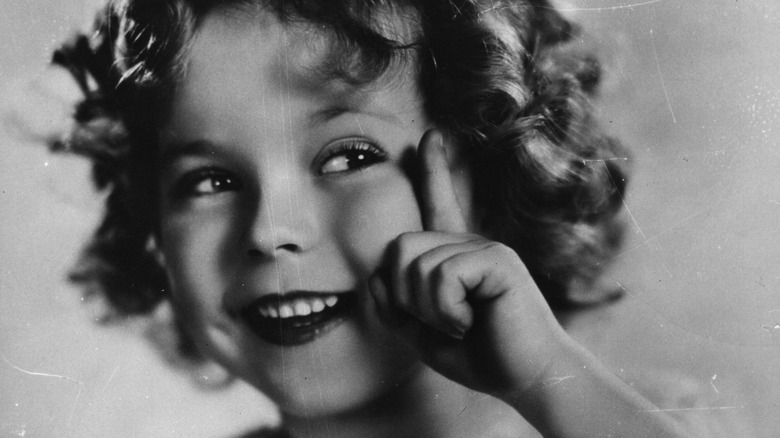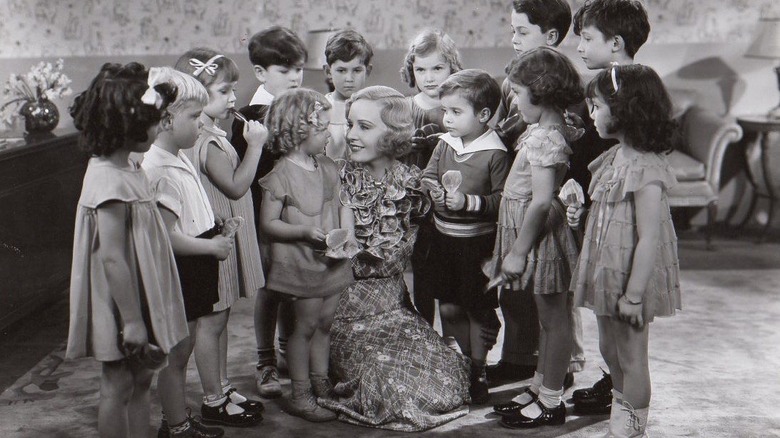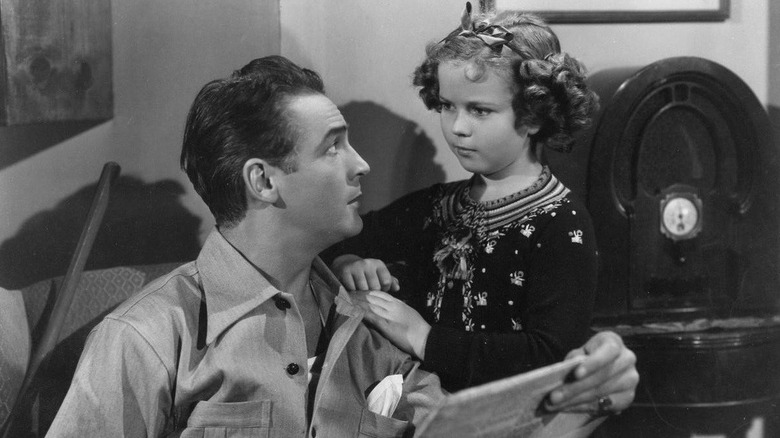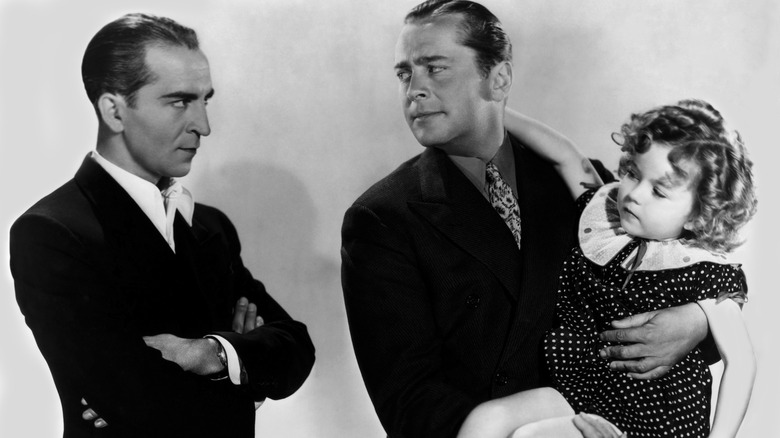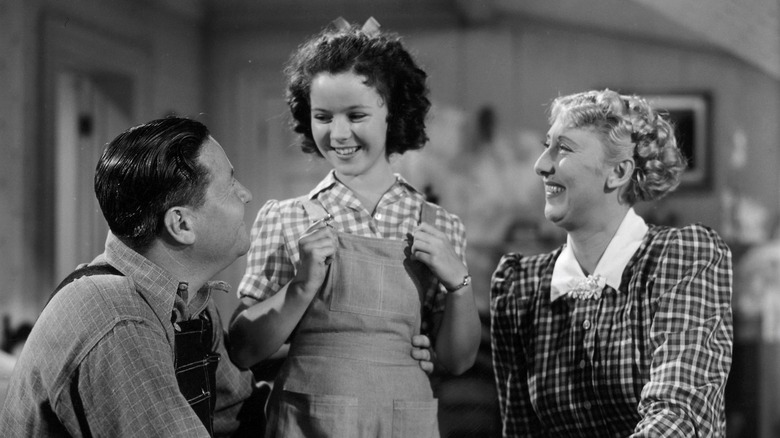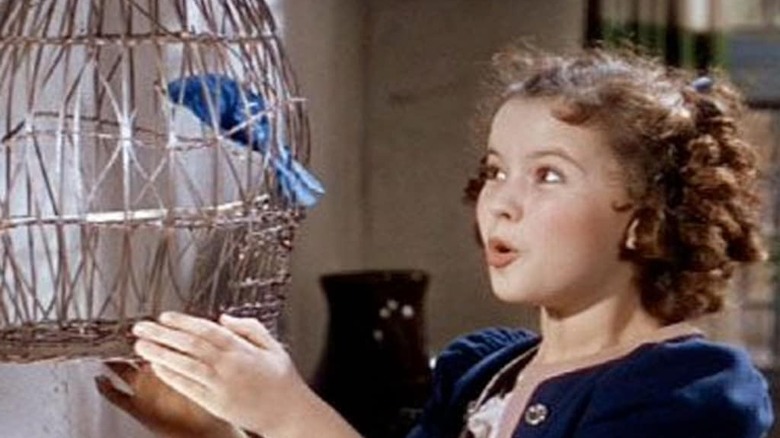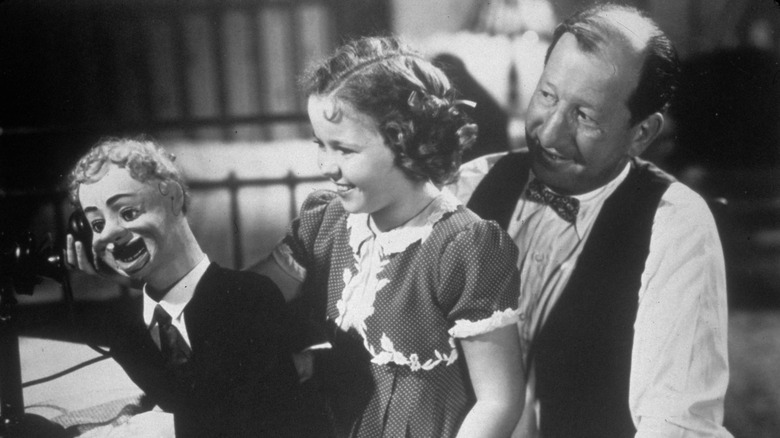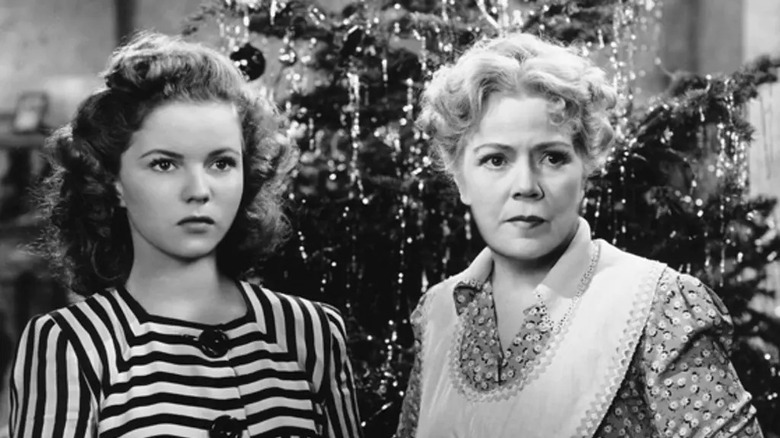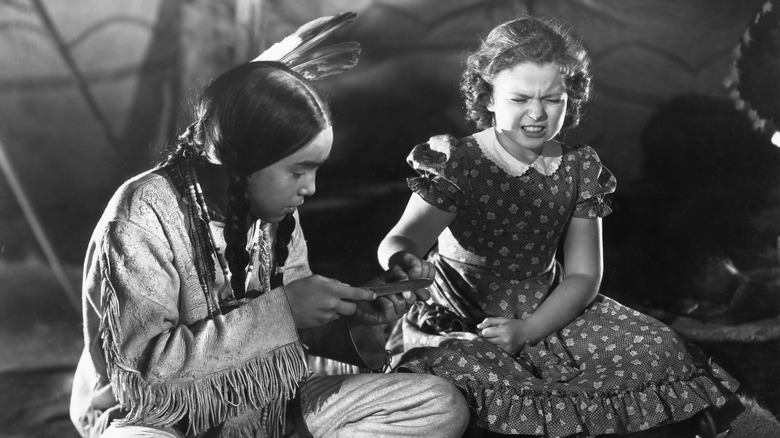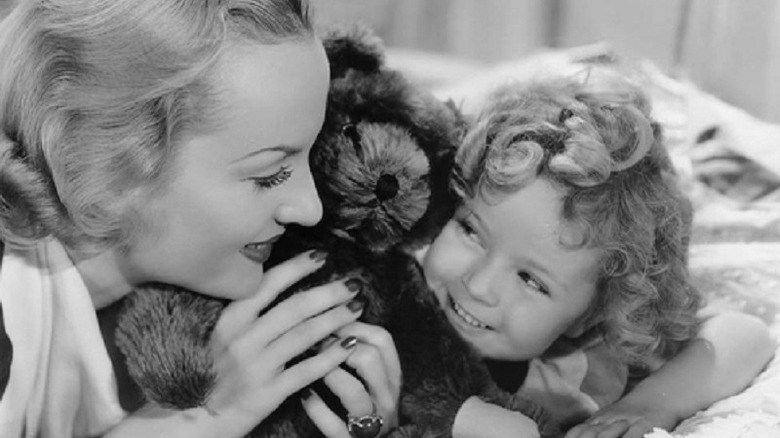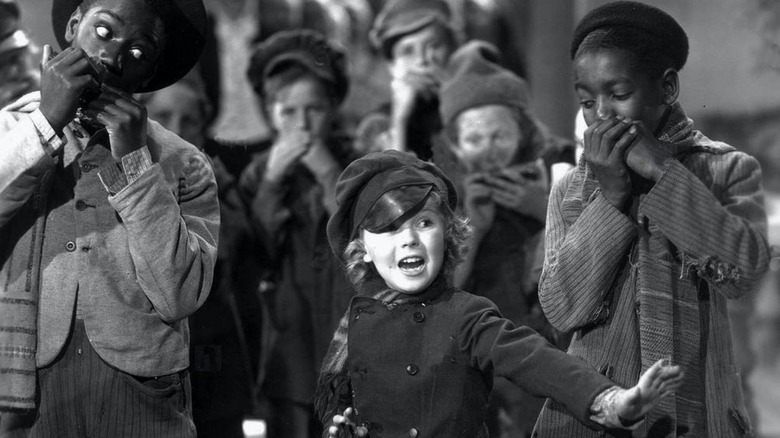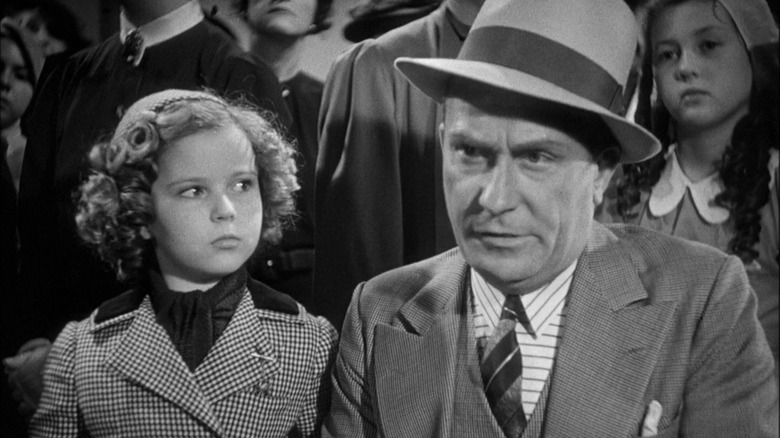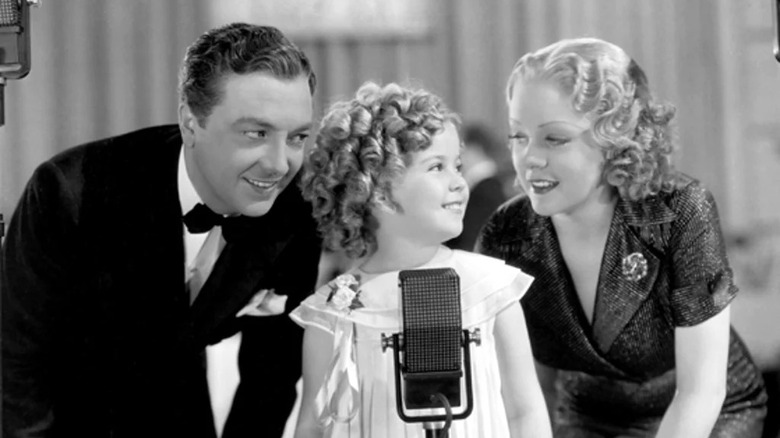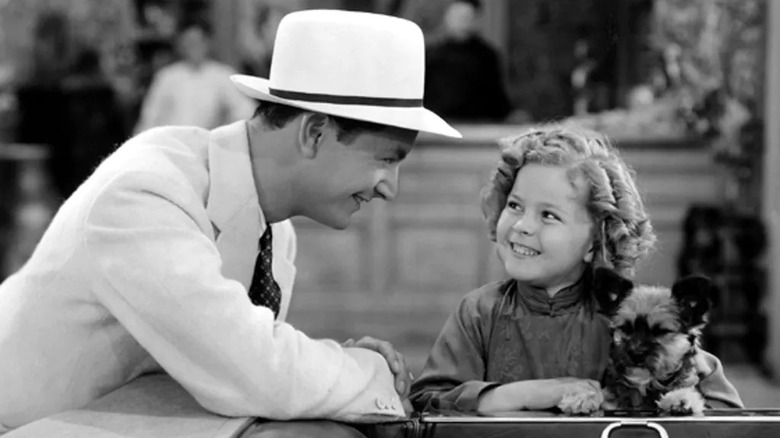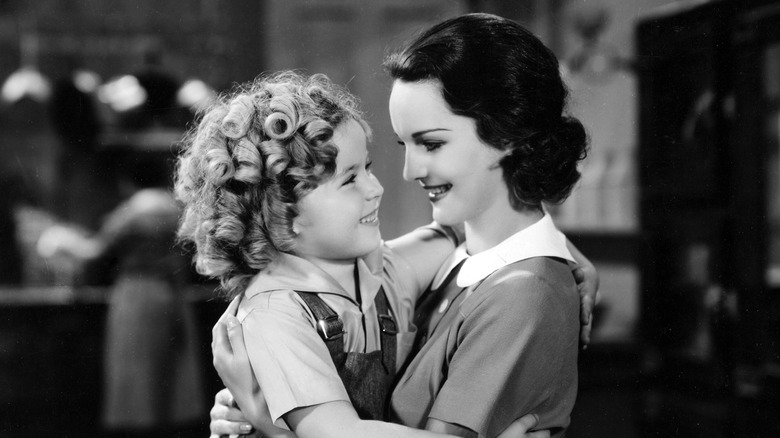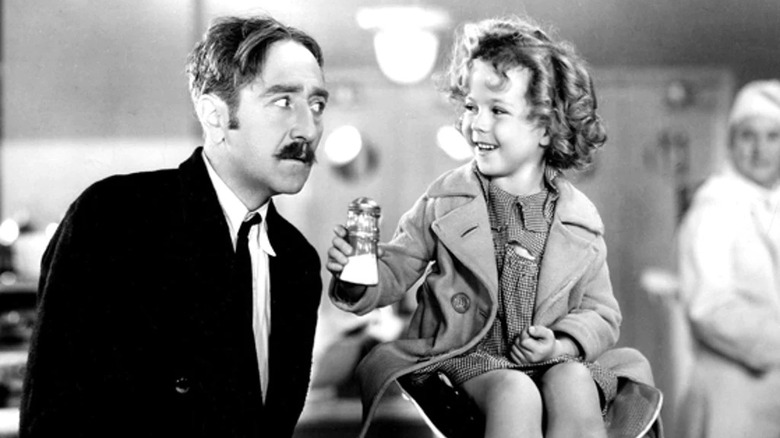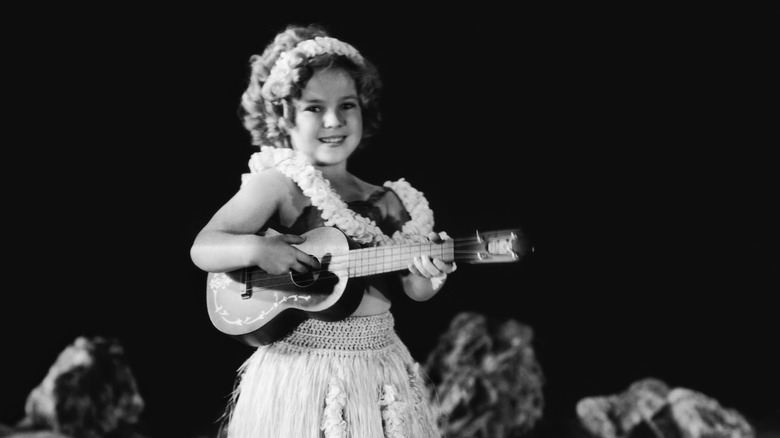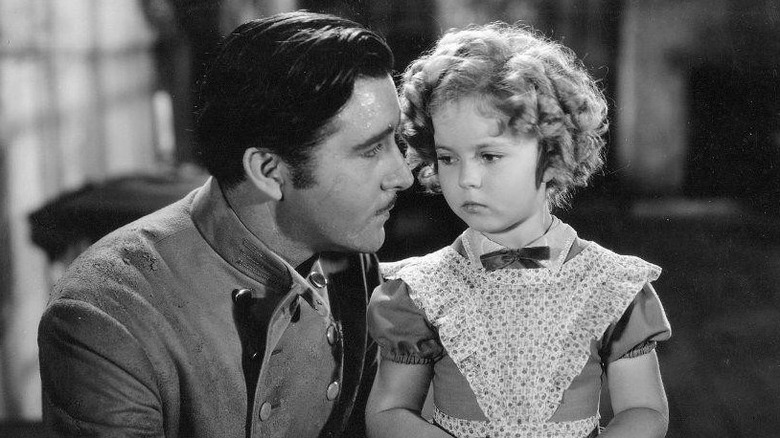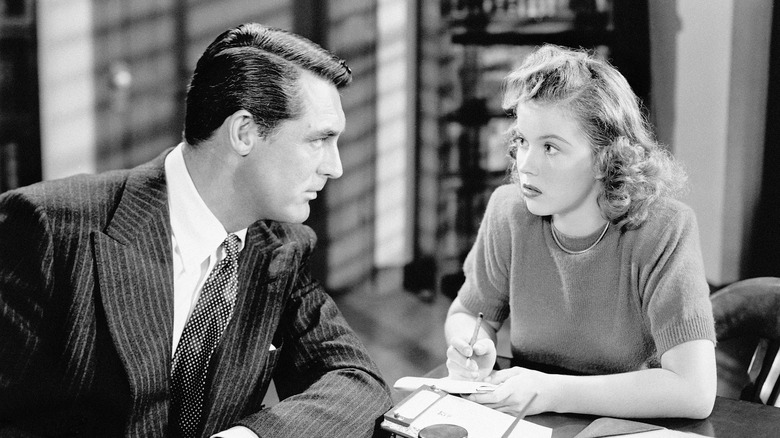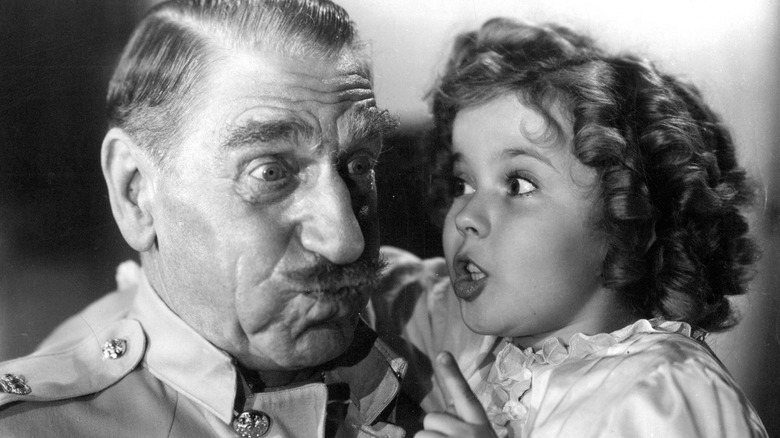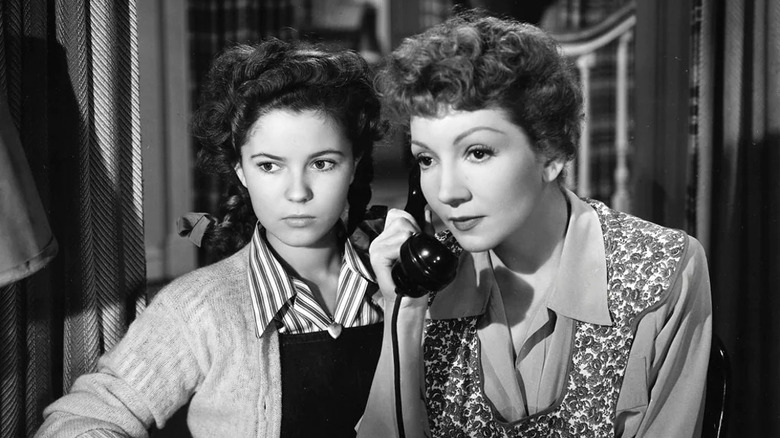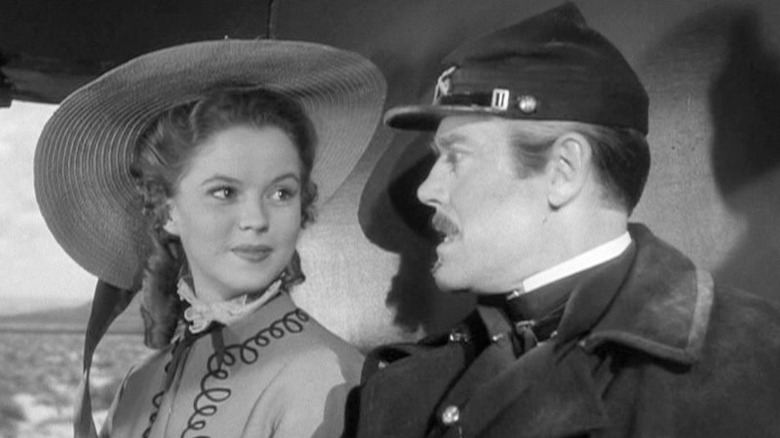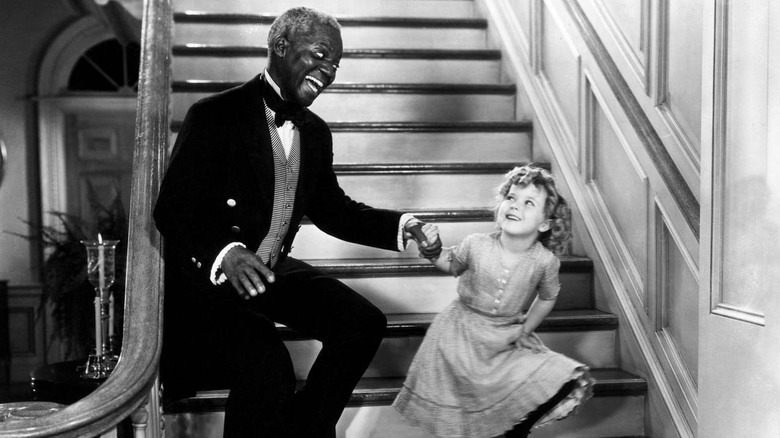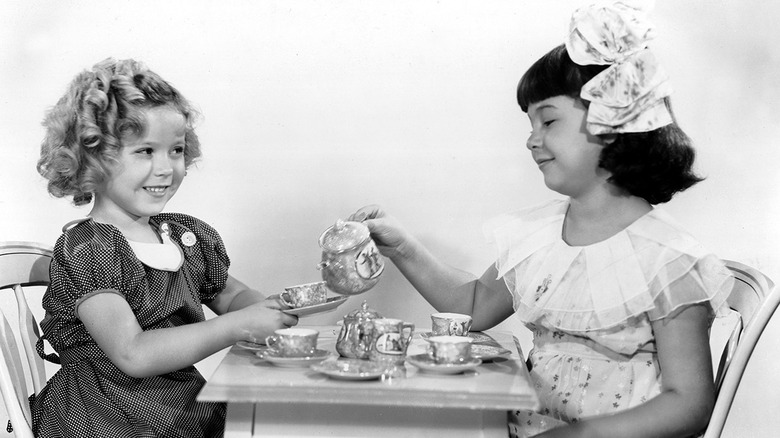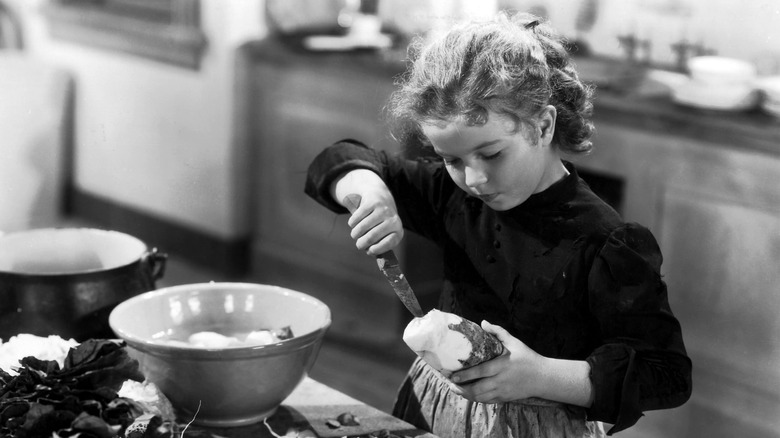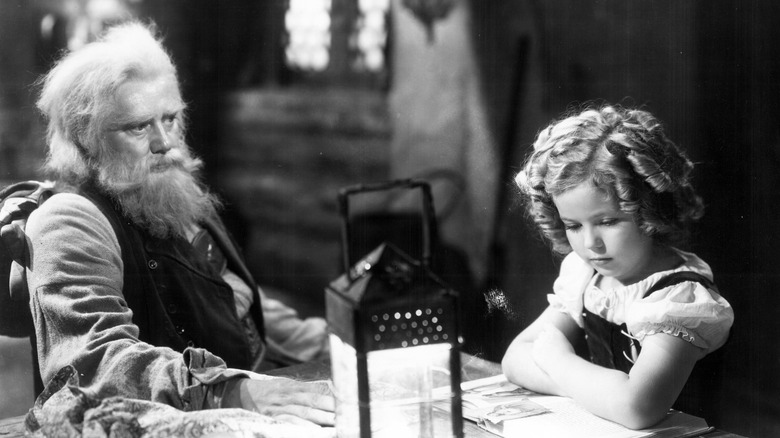25 Most Memorable Shirley Temple Movies Ranked Worst To Best
Shirley Temple perfectly embodied the American spirit, projecting endless optimism in the face of adversity. In the midst of the Great Depression, she was Hollywood's top box office star, offering audiences an undeniable sense of hope. As little Shirley proves in film after film, there's no problem you can't solve without grit, determination, and a little musical theater training.
Born in 1928, Temple began her movie career when she was just three years old, quickly becoming a superstar thanks to a small part in the musical review "Stand Up and Cheer!" Her rise was meteoric, and by 1935 she was so popular that the Academy Awards honored her with a special Juvenile Award.
By the time she was six years old, she was already starring in multiple films a year, the majority of which were thinly-plotted comedies or melodramas built around her singing and dancing skills, as she famously performed alongside the likes of Jack Haley, Buddy Ebsen, Jimmy Durante, and Bill "Bojangles" Robinson.
Temple retired from film acting in 1950 when she was just 22 years old. Between 1974-1989, she served as a diplomat for the United States under her married name, Shirley Temple Black. She was awarded a star on the Hollywood Walk of Fame in 1960, received the Kennedy Center Honors in 1998, and earned a Lifetime Achievement Award from the Screen Actors Guild in 2006. She died in 2014 at the age of 85.
Let's take a look back at Temple's 25 most memorable movies, ranked worst to best.
25. Stand Up and Cheer! (1934)
"Stand Up and Cheer!" was truly a star-making moment for Temple. Before then, the pint-sized performer's movie roles were almost as small as she was; after its release in 1934, she was the main attraction and would remain at the top of the box office charts for the rest of the decade.
Directed by Hamilton MacFadden, "Stand Up and Cheer!" is typical of the musical revues released by Hollywood throughout the Depression. Broadway producer Lawrence Cromwell (Warner Baxter) is appointed head of the newly created Department of Amusement, a governmental program meant to boost optimism while Americans wait on the breadlines. He assembles a crack team of entertainers to send out across the country, including a children's division run by Mary Adams (Madge Evans).
That's where Temple comes in as Shirley Dugan, who performs "Baby, Take a Bow" with Jimmy Dugan (James Dunn). (Their number was so popular that it served as the title for Temple and Dunn's next film, "Baby, Take a Bow," also released in 1934). Although the film itself isn't particularly memorable (the New York Times review called it "good entertainment" despite "several intrusive numbers which have little to do with the bright pivotal idea,") it at least did the job of introducing Depression-era audiences to their newest movie star.
24. Just Around the Corner (1938)
Temple churned out a ton of films throughout the 1930s, most of which were little more than an excuse for the little tyke to show off her song and dance skills. In "Just Around the Corner," she plays Penny Hale, whose father, Jeff (Charles Farrell), has been hit hard by the Great Depression. A once-promising architect, Jeff now scrapes by as a hotel janitor. Informed that the country is in such dire straits because of too many people trying to siphon money from "Uncle Sam," Penny befriends wealthy businessman Samuel G. Henshaw (Claude Gillingwater Sr.), the uncle of Jeff's girlfriend, Lola (Amanda Duff), in the hopes that he'll start a new building project and put her dad in charge.
In order to raise funds for the project, little Penny puts on — what else? — a musical revue charging attendees a nickel apiece. She performs with the hotel's doorman, Corporal Jones (Bill Robinson). This would mark the last time Temple appeared alongside her most famous dance partner, with whom she'd made three previous films. Needless to say, their routine manages not just to get Penny's dad back to work, but singlehandedly ends the Depression as well.
23. Baby, Take a Bow (1934)
Temple shot to stardom performing "Baby, Take a Bow" with James Dunn in the 1934 musical revue "Stand Up and Cheer!," and the number was so popular that the two were reunited that same year on a film called "Baby, Take a Bow," capitalizing on its success. Based on the play "Square Crooks" by James P. Judge, it tells the story of ex-con Eddie Ellison's (Dunn) attempts to go straight after he's released from prison. He marries his sweetheart, Kay (Claire Trevor), and they become parents to a precocious little girl named — appropriately enough — Shirley (Temple). He even helps his ex-con friend Larry (Ray Walker) get a job as a chauffeur. But things get serious when career criminal Trigger Stone (Ralf Harolde) steals a pearl necklace and a private investigator (Alan Dinehart) suspects that Eddie and Larry had something to do with it.
Little Shirley eventually comes into possession of the necklace, thinking it's a birthday present for her. She returns the necklace to its rightful owner, and is gifted a $5000 reward for her efforts. Although the subject matter is pretty dark, Temple and Dunn did manage to perform one musical number together, the catchy "On Account-a I Love You," giving audiences exactly what they paid for.
22. Young People (1940)
All good things must come to an end, and as the 1930s came to a close, little Shirley Temple and her fans had to reckon with the realities of growing up. "Young People" was the last film Temple made as a child star, and it marks the beginning of her decline as a top box office draw.
Directed by Allan Dwan, it stars Temple as Wendy Ballantine, whose vaudevillian parents Joe (Jack Oakie) and Kit (Charlotte Greenwood) decide to retire from show business and move to a sleepy New England town. Despite their best efforts, the locals don't take too kindly to "show folk," until a massive hurricane hits and the Ballantines prove their worth to the community.
Bosley Crowther of the New York Times wrote, "Now that Mistress Shirley Temple, the little ray of sunshine in a lot of people's lives, is about to withdraw from the screen at the ripe young age of eleven," it is "appropriate and sweetly touching that Twentieth Century Fox should mark the parting with a sentimental little picture about retired vaudevillians." His review makes it sound as though "Young People" marked its star's real-life retirement, and in a sense, it did: the film's poor box office performance, coupled with the failure of "The Blue Bird" that same year, effectively ended Temple's contract with the studio that made her a star. Although she didn't officially exit movie screens for another decade, Temple never regained the status she enjoyed as a child actress.
21. The Blue Bird (1940)
Temple's career as a child star ended in 1940, both because of her age (she turned 12 years old that year) and because her films stopped making money. That decline started with "The Blue Bird," a big-budget flop that was intended to be her version of "The Wizard of Oz" (1939), right down to the black-and-white prologue leading into glorious Technicolor. (Interestingly enough, Temple was actually considered for the role of Dorothy in "The Wizard of Oz," but she lost out to Judy Garland reportedly because her singing voice wasn't strong enough.)
Directed by Walter Lang, "The Blue Bird" is an adaptation of a 1908 Maurice Maeterlinck play set in Germany during the Napoleonic Wars. Temple plays Mytyl, a bratty woodcutter's daughter who refuses to give a beautiful blue bird to a sickly girl named Angela (Sybil Jason). During the night, Mytyl is visited by the fairy Berylune (Jessie Ralph), who sends her and her brother, Tyltyl (Johnny Russell), on a magical journey through the past, present, and future on a quest for the Blue Bird of Happiness.
Critical reception was lukewarm at best, with Frank S. Nugent of The New York Times saying, "As a children's show we suppose it is quite acceptable." Although it was a financial failure that ultimately lead to Temple leaving Twentieth Century Fox, "The Blue Bird" did manage to earn Oscar nominations for its cinematography and special effects.
20. Little Miss Broadway (1938)
Throughout the 1930s, Shirley Temple made a name for herself playing pretty much the same character: A plucky little go-getter who overcomes adversity with gumption and charm. In "Little Miss Broadway," she plays Betsy Brown, an orphan who moves into a boarding house for theater performers run by the kindly Pop Shea (Edward Ellis). The landlady, Sarah Wendling (Edna May Oliver), despises "show people" and wants to throw them all out of the building. But leave it to Betsy to come up with a solution: The building's residents will put on a show to raise money for the back rent Pop owes. At the same time, Sarah's nephew, Roger (George Murphy), wants to marry Pop's daughter, Barbara (Phyllis Brooks), and adopt Betsy, thus giving her a loving home.
As is the case with many Shirley Temple movies, you watch this one more for the musical numbers than the plot. Yet even though she has a few good numbers here with both Murphy and Jimmy Durante, by the time "Little Miss Broadway" came out, the act was beginning to wear thin. As Frank S. Nugent penned in The New York Times, "It can't be old age, but it does look like weariness." He adds, "Although she performs with her customary [gaiety] and dimpled charm, there is no mistaking the effort every dimple cost her." You'd half expect that review to be written by the miserly Miss Wendling, yet it reflects how critics were starting to view Temple's schtick at that point.
19. I'll Be Seeing You (1944)
Temple starred in two films produced by David O. Selznick in 1944: the Oscar-winning "Since You Went Away" and the largely forgotten "I'll Be Seeing You." Both films examine life on the home front during WWII, with Joseph Cotten playing the male lead in both. "I'll Be Seeing You" is a romantic melodrama about a traumatized war vet named Zachary Morgan (Cotten) who falls in love with Mary Marshall (Ginger Rogers), a convict on temporary leave for the Christmas holidays. Each tries to keep their respective condition a secret from the other, which threatens to upend their budding love affair.
While on leave, Rogers stays with her Aunt Sarah (Spring Byington), Uncle Henry (Tom Tully), and cousin Barbara (Temple) in their all-American home. Imprisoned for involuntary manslaughter, Mary has to earn back the trust of her family, especially Barbara, who marks all of her possessions when she's forced to share her room with her cousin. But when she learns the true circumstances behind Mary's crime, Barbara begs for forgiveness.
"I'll Be Seeing You" came at a time when Temple was growing out of child stardom and trying to find her footing as an adult actress (she was 16 at the time). Although she retired just five years later, her performance proves she had the chops to continue acting if she so desired.
18. Susannah of the Mounties (1939)
If there was one constant throughout Shirley Temple's filmography, it was the problematic representation of people of color. That certainly wasn't mutually exclusive to her: Many films made during Hollywood's so-called Golden Age feature harmful stereotypes. Among the most demonized groups at that time were Native Americans, who were often portrayed as savages in Westerns. While "Susannah of the Mounties" has its fair share of this, it at least attempts to humanize Indigenous characters instead of casting them all as villains.
Adapted from the novel by Muriel Denison, it stars Temple as pint-sized Susannah Sheldon, whose family is killed in an Indian attack while making their way through the Canadian frontier in the early 1880s. She's adopted by kindly mounted policeman Angus "Monty" Montague (Randolph Scott), but attacks from the Natives intensify as resentment grows over white settlers encroaching on their land. Chief Big Eagle (Maurice Moscovitch) tries to broker peace, and Susannah strikes up a friendship with his son, Little Chief (Martin Good Rider).
One area in which "Susannah of the Mounties" was ahead of its time was in the casting of actual Native American actors as extras, when most Hollywood productions employed either Hispanic or Caucasian performers (including this one, with Ukrainian Moscovitch playing Chief Big Eagle). 12 Blackfoot Indians were featured in the film, including Martin Good Rider in the role of Little Chief.
17. Now and Forever (1934)
1934 was a banner year for Temple, beginning with her breakout performance in "Stand Up and Cheer!" She had roles in six other films within that same 12-month span, including a plum dramatic part in this melodramatic weepie. Directed by Henry Hathaway, it stars Gary Cooper as Jerry Day, a career swindler who's willing to sell custody rights to his estranged daughter, Penny (Temple), for some quick cash — much to the horror of his new wife, Toni (Carole Lombard). But when he finally meets the little tyke, he's instantly charmed by her, and decides to go straight.
Jerry has a hard time providing for his family, however, and soon enough he's falling back on his old ways. He steals a valuable necklace from the kindly Mrs. Crane (Charlotte Granville) to sell to his criminal friend, Evans (Sir. Guy Standing). When Penny discovers the stolen jewelry hidden in her teddy bear, Toni takes the blame, renewing Penny's faith in her father. Overcome with guilt, Jerry tries to get the necklace back from Evans, threatening him with a gun; Evans shoots Jerry, and Jerry kills Evans. He returns the necklace to Mrs. Crane, who vows not to tell the police if Jerry agrees to let Penny go to boarding school.
Temple earned rave reviews for her performance, with The New York Times saying, "The little girl has lost none of her obvious delight in her work during her rise to fame."
16. Dimples (1936)
As Frank S. Nugent of the New York Times put it, "'Dimples' is not the best Temple, nor the worst." That's a pretty accurate way to describe this mid-tier Shirley Temple offering, which has a ridiculous plot, some cringe-inducing racism, and a handful of charming musical numbers.
Set in New York in the 1850s, it stars Temple as Sylvia Appleby, aka "Dimples," a precocious street performer who lives with her pickpocket grandfather, Professor Eustace Appleby (Frank Morgan), on the Bowery. She performs at a soiree for wealthy widow Caroline Drew (Helen Westley), who takes Dimples into her lavish home on Washington Square Park. There she meets Caroline's nephew, Allen (Robert Kent), a Broadway producer who wants Dimples to play Little Eva in his production of "Uncle Tom's Cabin."
But little Dimples longs for her grandfather and is determined to lift him out of poverty. Ultimately everything works out for the best, and Dimples stars in Broadway's very first minstrel show. As you can imagine, many scenes in the film are difficult to view through a modern lens (particularly the "Dixie-anna" number featuring performers in blackface). But the dance sequences, which were choreographed by Temple's frequent collaborator, Bill "Bojangles" Robinson," remain stunning to watch in spite of how problematic some of them are.
15. Rebecca of Sunnybrook Farm (1938)
Throughout the 1930s, if there was a popular children's book getting adapted into a movie, Shirley Temple was the obvious choice to star. This was actually the third film version of Kate Douglas Wiggins' beloved 1903 novel, "Rebecca of Sunnybrook Farm," and by far the best-remembered, thanks to Temple's involvement.
Directed by Allan Dwan, it stars Temple as Rebecca Winstead, a gifted orphan living with her curmudgeonly stepfather, Harry Kipper (William Demarest). After mistakenly believing she's blown an audition for a radio advertisement, Harry sends her away to live with her Aunt Miranda (Helen Westley) at Sunnybrook Farm. Aunt Miranda despises show people, and aims to keep her niece out of the business. But advertising executive Tony Kent (Randolph Scott) wants to hire Rebecca for that radio campaign, and desperately searches for her without realizing she lives on the farm next door to his. Things are further complicated by Tony's romance with Rebecca's cousin, Gwen (Gloria Stuart, who played the older version of Rose in "Titanic").
"Rebecca of Sunnybrook Farms" works almost as a tribute to Shirley Temple, with many of its best moments referencing memorable scenes from her other movies. In one moment, Temple performs a medley comprised of some of her biggest hits, including "On the Good Ship Lollipop," "Animal Crackers in My Soup," and "Goodnight My Love." In another, she dances on a flight of stairs with Bill Robinson in a scene reminiscent of their famous number in "The Little Colonel" (1935), this time clad as toy soldiers and stepping to "The Toy Trumpet."
14. Poor Little Rich Girl (1936)
Like most Shirley Temple movies, "Poor Little Rich Girl" isn't exactly a model of plot construction. As Frank S. Nugent wrote in The New York Times, the script is "formless and generally ridiculous." Yet even though as a movie, it's "virtually nonexistent," Nugent conceded that "as a display window for the ever-expanding Temple talents, it is entirely satisfying." And that's about what you can expect from one of the actress's best films.
Temple plays Barbara Barry, the emotionally neglected daughter of widower Richard Barry (Michael Whalen), a wealthy soap manufacturer. Mr. Barry decides to send Barbara off to boarding school, but she gets lost at the train station when her nanny, Collins (Sara Haden), is struck by a taxi. Posing as an orphan, Barbara finds her way into the tenement apartment of an Italian organ-grinder, Tony (Henry Armetta), who feeds her spaghetti and tucks her into bed with his own children.
She soon meets married vaudevillians Jimmy and Jerry Dolan (Jack Haley and Alice Faye), who live upstairs. Impressed by her vocal talents, the Dolans decide to turn their act into a trio, and they become overnight successes thanks to advertising executive Margaret Allen (Gloria Stuart). But little Barbara misses her dad, and they're soon reunited, thanks to the power of radio.
13. Stowaway (1936)
Little Shirley goes East for "Stowaway," one of many Hollywood films at the time to portray Asia as an exotic and mysterious place. She plays Barbara Stewart, aka "Ching-Ching," an American orphan living in Shanghai with her dog, Mr. Wu. Barbara's missionary family was killed in a village attack, and she's been on her own ever since. That all changes when she befriends American playboy Tommy Randall (Robert Young), who's touring around the world in an ocean liner. When Barbara and her puppy fall asleep in the trunk of Tommy's convertible, she inadvertently becomes a stowaway when the car is loaded onto the ship he's traveling on. Luckily for Barbara, Tommy and his sweetheart, Susan Parker (Alice Faye), are looking to adopt.
Reviews for the film were better than expected, with Frank S. Nugent of The New York Times raving, "For the first time in several starts [Temple] has an amusing script behind her, an agreeable adult troupe with her and a clever director before her. The combination has produced a thoroughly entertaining romantic comedy." That's good news for Shirley, who went above and beyond preparing for the role of an American girl living in Shanghai, even taking six months to learn 40 words in Mandarin Chinese. (She also later adopted the dog who played Mr. Wu, renaming him Ching-Ching.)
12. Curly Top (1935)
You might not remember the plot of "Curly Top," but you'll certainly remember the musical numbers. It's hard to forget Shirley singing "Animal Crackers in My Soup," which remains, alongside "On the Good Ship Lollipop," one of the most iconic songs she ever performed.
Temple plays Elizabeth Blair, a precocious tyke who resides at the Lakeside Orphanage with her sister, Mary (Rochelle Hudson), who works in the kitchen. Little Elizabeth keeps her fellow orphans entertained by singing songs written by her sister, including, of course, "Animal Crackers in My Soup." Her talents catch the eye of Edward Morgan (John Boles), a wealthy trustee who offers to adopt her when her hijinks anger the orphanage administrators. But Elizabeth won't leave without her sister, and soon the two are living in Edward's lavish estate, where romance sparks between him and Mary.
Critical reception was on par for most Shirley Temple movies. As Andre Sennwald of The New York Times put it, "So shameless is [the movie] in its optimism, so grimly determined to be cheerful, that it ought to cause an epidemic of axe murders and grandmother beatings in this sober vicinity." He did praise Temple, saying, "Her remarkable sense of timing has never been revealed more plainly than in the song and dance scenes in her new film, and she plays her straightforward dramatic scenes with the assurance and precision of a veteran actress."
11. Little Miss Marker (1934)
"Little Miss Marker" was Temple's first leading role in a feature film, and went a long way towards establishing her as America's favorite movie star. Based on a story by tough guy poet Damon Runyon, it casts Temple as Marthy Jane, aka "Marky," whose father puts her up as collateral for a $20 bet. When her dad dies by suicide after losing the bet, she's sent to live with his bookie, Sorrowful Jones (Adolphe Menjou). Although he's ill-equipped for fatherhood, Markey soon works her charms on Jones, convincing him to leave the racetrack and his crooked boss, Big Steve Halloway (Charles Bickford), behind for a life with his girlfriend, Bangles Carson (Dorothy Dell).
"Little Miss Marker" remains one of Temple's best-reviewed films. Writing in the New York Times, Mordaunt Hall said it was "a delight in many respects, for it has been produced so pleasingly and with such efficient portrayals that only a dyed-in-the-wool cynic could fail to be affected by its sterling humor and pathos." Of Temple, Hall wrote, "no more engaging child has been beheld on the screen." He added, "Tiny Shirley Temple is a joy to behold and her spontaneity and cheer in speaking her lines are nothing short of amazing." Depression-era audiences agreed, and soon the talented tyke was moving from hit to hit.
10. Captain January (1936)
"Captain January" is another in a long line of movies casting Shirley Temple as a precocious orphan who brightens the lives of her adoptive family. Adapted from the 1890 novel by Laura E. Richards, it centers on Helen "Star" Mason (Temple), who was taken in as a baby by kindly lighthouse keeper Captain January (Guy Kibbee) after her parents were killed at sea. Although she enjoys living with Captain January and his friends, Captain Nazro (Slim Summerville) and Paul Roberts (Buddy Ebsen), nosey truant officer Agatha Morgan (Sara Haden) believes Star belongs in a proper home. She locates Star's long-lost aunt and uncle (Nella Walker and George Irving), threatening to separate her from her surrogate family forever.
In his review for the New York Times, Frank S. Nugent found Temple to be "as clever and talented as ever." Yet he ultimately concluded that even her "glories" couldn't "atone for 'Captain January's' moss-covered script." He did enjoy individual scenes, such as Temple "tap-dancing the multiplication table... down a flight of steps" and her rendition of "At the Codfish Ball" with Ebsen, who he said, "yet may be her Fred Astaire when she has grown up to become a latter-day Ginger Rogers."
9. The Littlest Rebel (1935)
When evaluating Temple's filmography, one has to deal honestly with the racism present in some of her most beloved movies. It's unfair to lay the blame on Temple, who was, after all, a child at the time, and had little creative input in the roles she was assigned. Yet it is an important point of discussion when assessing some of her work, particularly two 1935 films set during the Civil War: "The Little Colonel" and "The Littlest Rebel."
In "The Littlest Rebel," Temple plays Virgie Cary, daughter of Confederate soldier Herbert Cary (John Boles). When her father is called for duty, Virgie is left on the family plantation in the care of their slave, Uncle Billy (Bill Robinson). Colonel Morrison (Jack Holt), an officer for the Union Army, becomes an unlikely ally when enemy troops plunder Virgie's home and her mother (Karen Morley) dies. Her father plots to transport her to safety with the help of Colonel Morrison, but their plan is discovered and both men are sentenced to death, leading Virgie and Uncle Billy to appeal to President Lincoln (Frank McGlynn Sr.) through song and dance.
Much like "Gone with the Wind," this film presents the slave-owning South as a Camelot destroyed by Yankee intrusion. As Andre Sennwald noted in the New York Times, "The stereotypical treatment of black characters in 'The Littlest Rebel' is more offensive than usual, with 'happy darkies' nervously pondering the prospect of being freed from slavery and shaking in their boots when the Yankees arrive."
8. The Bachelor and the Bobby-Soxer (1947)
Throughout the 1940s, Temple tried to make the transition from child star into adult leading lady, ultimately finding less success than her contemporaries Elizabeth Taylor and Judy Garland. One of her best films during this period, "The Bachelor and the Bobby-Soxer," hints at what her screen persona could have transformed into had she not ultimately retired from movie screens at the end of the decade.
Temple plays Susan Turner, a high school student living with her older sister, Margaret (Myrna Loy), a judge and Susan's legal guardian. Into their lives comes Dickie Nugent (Cary Grant), a sophisticated artist who's brought before Margaret's court for starting a fight between two women in a nightclub. Dickie is able to charm his way out of sentencing, and later that day he turns up as a guest lecturer at Susan's school. Susan instantly falls in love with him, and she sneaks into his bachelor pad in the hopes of seducing him. When Margaret and Assistant District Attorney Tommy Chamberlain (Rudy Vallee) discover her there, a brawl ensues between Tommy and Dickie, and to avoid assault charges, Dickie agrees to date Susan until her infatuation wears off.
Writing for The New York Times, Bosley Crowther said Temple was given "a full chance to show her natural charm as a clear-eyed, imaginative, persistent, and overpowering 17-year-old," proving age did nothing to dull her acting talents.
7. Wee Willie Winkie (1937)
At first glance, Shirley Temple and John Ford seem an odd cinematic pairing. After all, one earned acclaim as a director of moody, elegiac westerns, while the other lifted Depression-era spirits with her song and dance routines. Yet Temple's relentless optimism in the face of adversity was well-suited to Ford's more sentimental side, which often found its way into his films.
In "Wee Willie Winkie," Temple plays Priscilla Williams, a precocious tyke who travels with her widowed mother, Joyce (June Lang), to a military outpost in British-occupied India to live with her grandfather, the no-nonsense Colonel Williams (C. Aubrey Smith). She quickly warms the hearts of everyone around her, including the lovable Sergeant Donald MacDuff (Victor McLaglen). Tensions arise when freedom fighter Khoda Khan (Cesar Romero) escapes captivity and rejoins rebel forces against the colonizers, but that's nothing Wee Willie Winkie can't handle. (Modern-day assessments of the film address its tone-deaf representation of colonial rule of India, which presents the British as benevolent in the face of native savagery.)
6. Since You Went Away (1944)
The 1940s were a rough period for Temple, as America's favorite child star struggled to find her footing as an adolescent. She found great success as a supporting actress during this period, particularly in David O. Selznick's "Since You Went Away," one of two World War II domestic dramas she made with the mega-producer (along with "I'll Be Seeing You," released the same year).
Directed by John Cromwell, it's an epic examination of life on the home front, centering on housewife Anne Hilton's (Claudette Colbert) struggle to raise her teenage daughters, Jane (Jennifer Jones) and Bridgette (Temple), while her husband is away fighting. Strapped for cash, Anne is forced to take in a pair of lodgers: cantankerous Col. William G. Smollett (Monty Wolley) and family friend Lt. Tony Willett (Joseph Cotten), with whom she has a chaste romance. Meanwhile, Jane falls in love with Smollett's estranged son, Bill (Robert Walker), who joins the Army to gain his father's respect.
In his review for The New York Times, Bosley Crowther criticized the film for having an "excess of exhausting emotional detail" but praised the performances, saying that Temple, "now grown to teenage freshness, is pert as the young sister." It's a sentiment most critics shared for the nearly three-hour melodrama, which earned nine Oscar nominations, including best picture.
5. Fort Apache (1948)
As a child, Temple worked with John Ford in 1937's "Wee Willie Winkie." As an adult, she reunited with the director in one of his most acclaimed films, the 1948 Western "Fort Apache." It was one of her final onscreen roles before she retired in 1950, and it hints at her potential as a dramatic actress.
Set in the immediate aftermath of the Civil War, it stars John Wayne as Capt. Kirby York, who's expected to take over command duties at the isolated U.S. cavalry post, Fort Apache. But that all changes with the arrival of celebrated war hero Lt. Col. Owen Thursday (Henry Fonda). Arrogant and obstinate, Thursday clashes with York over how to deal with the local Native American population. Thursday views them as savages and determines to engage them in battle, which York vehemently fights against. Temple costars as Thursday's daughter, Philadelphia, who falls in love with dashing young Second Lt. Michael Shannon O'Rourke (played by Temple's then-husband, John Agar).
Reviews for the film were outstanding, with Bosley Crowther of The New York Times calling Temple "ingratiating as the colonel's lass." Variety agreed, saying Temple "perks her sequences in romance with John Agar." It almost makes one wish Temple hadn't called it quits just a year later, considering she was still capable of turning in good work on-screen.
4. The Little Colonel (1935)
As with "The Littlest Rebel," it's impossible to watch "The Little Colonel" without commenting on its abject racism. Yet despite the objectionable subject matter at the core of both films, you can't help but marvel at the dance routines between Temple and her most famous collaborator, Bill "Bojangles" Robinson.
Set in the Antebellum South, the film stars Lionel Barrymore as Colonel Lloyd, who disowns his southern belle daughter Elizabeth (Evelyn Venable) when she marries a Northerner, Jack Sherman (John Lodge). Six years later, Elizabeth returns to the South with her spirited daughter, Little Lloyd (Temple), who learns of her family's tumultuous past from the Colonel's housekeeper, Mom Beck (Hattie McDaniel). Despite a rocky start, Colonel Lloyd forges a friendship with his granddaughter, and the two come together to save the family when Jack returns from a prospecting venture broke and sickly.
The film is best remembered for the moment when Temple dances on the staircase with Robinson, who costars as Walker the butler. It was the first interracial dance number on-screen, and as Mary C. Curtis noted in The Washington Post, "You can appreciate the exposure her films provided for the virtuoso tap dancer Robinson while noticing he usually played the servant or slave and the little one was always in charge. If Temple were a few years older — in real life or the movies — their hand-holding partnership would have triggered rage rather than fond affection."
3. Bright Eyes (1934)
One can point to "Bright Eyes" as the moment Shirley Temple went from being a popular child actress to a full-blown icon. With her performance of "On the Good Ship Lollipop," the young actress solidified her screen persona as a precocious go-getter who could lift anyone's spirit through song and dance.
The film casts Temple as Shirley Blake, who loses her father in a plane crash and lives with her mother, Mary (Lois Wilson), at the home of the Smythe family, where Mary works as a maid. The Smythes don't care too much for little Shirley, save for cantankerous Uncle Ned (Charles Sellon). She spends most of her time with her godfather, James "Loop" Merritt (James Dunn), a pilot who flew with Shirley's dad. When Mary is killed in a traffic accident, the Smythes want to send her away to an orphanage, but Uncle Ned objects. A bitter custody battle ensues between Ned and Loop, who ultimately decide to raise her together with the help of Loop's fiancee, Adele (Judith Allen).
The plot is, of course, melodrama at its most manipulative. But that doesn't matter when you watch Shirley perform "On the Good Ship Lollipop" to a captive audience of aviators who are showing her around the runway her father used to take off from. That performance, paired with her numerous other films released in 1934, lead to Temple winning a special Juvenile Award at the Oscars.
2. The Little Princess (1939)
Released at the end of the 1930s, "The Little Princess" marked the end of Temple's reign as Hollywood's most successful child star. It's also one of her very best films, a shining example of what could happen when the young actress was given a script that was equal to her talents. Adapted from Frances Hodgson Burnett's classic 1905 children's book, it's the story of Sara Crewe (Temple), an intrepid little girl who goes from army hospital to army hospital in search of her missing father, Captain Reginald Crewe (Ian Hunter), reported dead while fighting in the Second Boer War.
This was Temple's first movie to be shot in Technicolor (others would later be presented in computer-colorized versions), giving audiences a chance to finally see her golden locks in all their glory. It also shows off the lavish production mounted by producer Darryl F. Zanuck and director Walter Lang, which spares no expense in transporting audiences back to Victorian-era London through period sets and costumes.
Yet as always, it's Temple who shines brightest. The New York Times called the part of Sara Crewe "undoubtedly her greatest role to date," adding that, "with any other child on earth," the film "would stand out as one of the most glaring exhibits of pure hokum in screen history."
1. Heidi (1937)
Although Johanna Spyri's 1881 children's book "Heidi" has been adapted too many times to count, one can hardly think of the chipper little Swiss orphan without picturing Shirley Temple's smiling face. Of all the roles she assumed throughout her career, few have played so well to her unique screen persona as this one, and fewer still hold up as well in terms of overall quality.
Directed by Allan Dwan, it stars Temple as Heidi, who's sent to live with her hermit grandfather, Adolph (Jean Hersholt), in the Swiss Alps. Although he's grouchy at first, Adolph's heart is quickly melted by the sweet little girl. But Heidi's aunt Dete (Mady Christians) steals her from her home and sells her as a servant to the wealthy Herr Sesemann (Sidney Blackmer). As Adolph embarks on a journey to rescue her, Heidi makes friends with Sesemann's disabled daughter, Klara (Marcia Mae Jones).
Reviews at the time were strong, with Frank S. Nugent of the New York Times saying "it contains all of the harmless sweetness and pretty pictures one expects to find on the juvenile shelf." It remains one of the most acclaimed entries in Temple's filmography and represents well her unique talents as a performer.
